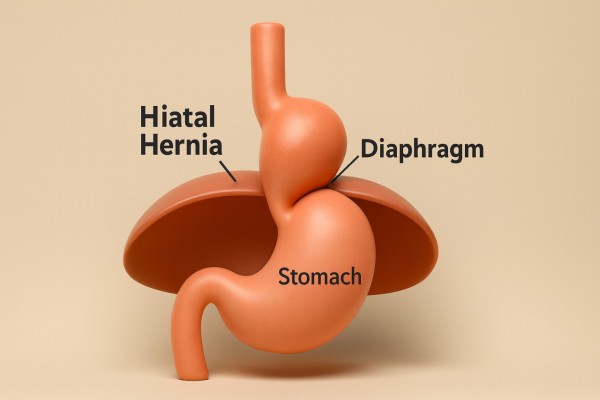What is a Hiatal Hernia?
A hiatal hernia is a common condition that occurs when part of your stomach pushes up through an opening in your diaphragm (the muscle that separates your chest from your abdomen). The diaphragm is shaped like a dome and has a natural opening that allows the esophagus (the tube that carries food from your mouth to your stomach) to pass through it. When this opening widens or weakens, a portion of the stomach can slide up through it into the chest cavity.
Types of Hiatal Hernia:
There are two main types of hiatal hernias:
* Sliding Hiatal Hernia: This is the most common type, where a portion of the stomach and the lower esophagus slide up and down through the diaphragm's opening. This type often causes no symptoms or only mild symptoms.
* Paraesophageal Hiatal Hernia: This type is less common but can be more serious. In this case, the top part of the stomach remains in its place, but another part of the stomach pushes up alongside the esophagus through the diaphragm's opening. This part of the stomach can become trapped, potentially leading to problems with blood flow or compression of the esophagus.
What Causes a Hiatal Hernia?
The exact cause of a hiatal hernia isn't always clear, but several factors can increase the risk of developing one:
* Aging: The risk of developing a hiatal hernia increases with age as muscles and tissues weaken.
* Increased Abdominal Pressure: Anything that increases pressure in the abdominal area can contribute to a hernia, such as:
* Chronic or severe coughing.
* Frequent vomiting.
* Straining during bowel movements (constipation).
* Lifting heavy objects.
* Pregnancy.
* Obesity and excess weight.
* Congenital Defects: In some cases, a person is born with a larger-than-usual opening in the diaphragm.
* Injuries: Abdominal injuries can lead to a hiatal hernia.
What are the Symptoms of a Hiatal Hernia?
Many people with a hiatal hernia experience no symptoms at all, especially with small sliding hernias. However, when symptoms do appear, they are usually related to acid reflux (GERD) or entrapment of part of the stomach. Common symptoms include:
* Heartburn: A burning sensation in the chest, often worsening after eating or when lying down.
* Regurgitation: A sensation of stomach acid or food coming back into the throat or mouth.
* Chest Pain: Pain can be mild or sharp and may be mistaken for a heart attack.
* Difficulty Swallowing: Feeling like food is stuck in the throat or chest.
* Frequent Burping.
* Abdominal Bloating.
* Nausea and Vomiting.
* Shortness of Breath: In rare cases, a large hernia can compress the lung.
* Anemia: If there is minor, chronic bleeding from the herniated part of the stomach.
When Should You See a Doctor?
If you experience any of the symptoms mentioned above, especially frequent or severe heartburn, chest pain, or difficulty swallowing, it's important to see a gastroenterologist for proper diagnosis and treatment.
Diagnosis:
To diagnose a hiatal hernia, your doctor may perform one or more of the following tests:
* Barium X-ray: The patient drinks a liquid containing barium, which coats the lining of the digestive tract and makes it visible on X-rays, allowing the doctor to see the position of the stomach.
* Upper Endoscopy (EGD): A thin, flexible tube with a small camera is inserted through the throat to examine the esophagus and stomach.
* Esophageal pH Monitoring: This test measures the amount of acid that refluxes into the esophagus.
* Esophageal Manometry: This test measures the strength of the esophageal muscles during swallowing.
Treatment:
Treatment for a hiatal hernia depends on the severity of symptoms and the type of hernia.
Non-Surgical (Conservative) Treatment:
Non-surgical treatment aims to relieve symptoms, especially those related to acid reflux. Your doctor may recommend:
* Lifestyle Changes:
* Avoid trigger foods and drinks: Such as fatty, fried, spicy foods, citrus, chocolate, peppermint, coffee, and carbonated beverages.
* Eat small, frequent meals: Instead of large ones.
* Avoid lying down immediately after eating: Wait at least two to three hours before going to bed.
* Elevate the head of your bed: By about 6-8 inches to help gravity keep acid in the stomach.
* Lose weight: If you are overweight or obese.
* Quit smoking: As smoking weakens the esophageal sphincter.
* Avoid tight clothing around the waist.
* Medications:
* Antacids: To quickly relieve heartburn.
* H2 blockers: Such as famotidine, to reduce acid production.
* Proton pump inhibitors (PPIs): Such as omeprazole and lansoprazole, which are the most potent medications for reducing acid production.
Surgical Treatment:
Surgical intervention may be necessary in cases that do not respond to medication and lifestyle changes, or in cases of large paraesophageal hernias that cause severe symptoms or complications. The surgery aims to return the stomach to its normal position and tighten the opening in the diaphragm.
Tips for Living with a Hiatal Hernia:
* Follow your doctor's instructions carefully.
* Adhere to your diet plan and avoid trigger foods.
* Maintain a healthy weight.
* Exercise regularly (but avoid exercises that increase abdominal pressure).
* Stop smoking.
* Avoid stress and anxiety, as they can affect the digestive system.
We wish you continued health and well-being. If you have any questions or are experiencing symptoms of a hiatal hernia, please do not hesitate to visit our clinic for evaluation and appropriate care.


